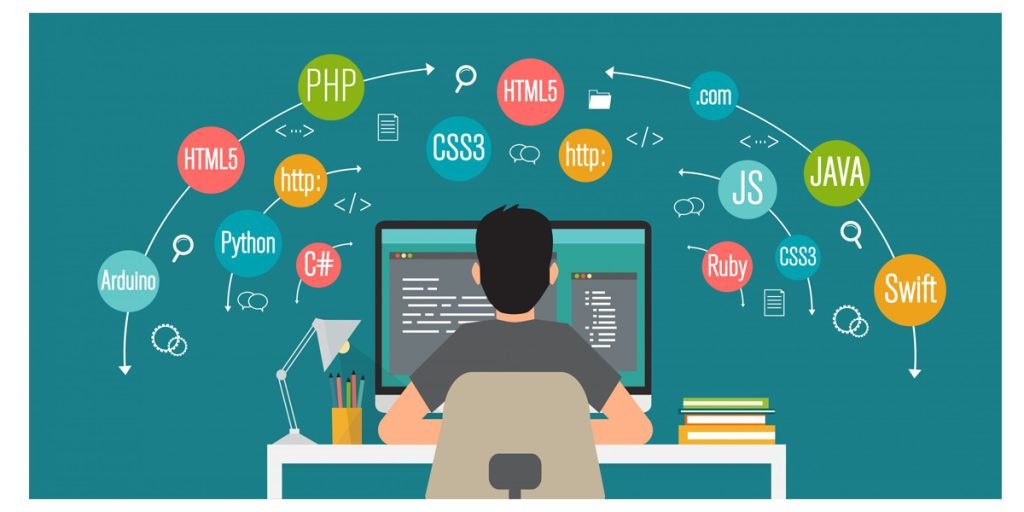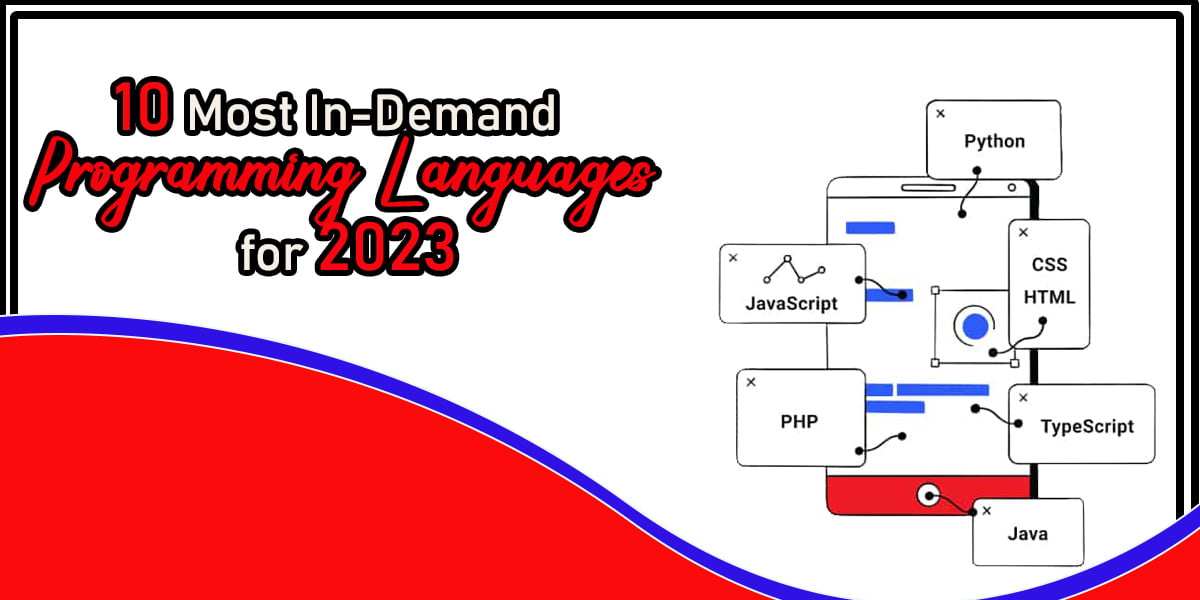10 Most In-Demand Programming Languages for 2023
The demand for skilled programmers continues to soar as the world becomes increasingly digital. The technology landscape constantly evolves, with new programming languages and existing ones undergoing significant updates. Staying updated with the latest trends is essential for aspiring developers and seasoned professionals alike. In this article, we’ll look at the 10 most in-demand programming languages for 2023, exploring the features and applications of each and why they are poised to be among the most sought-after skills in the tech industry. Whether you’re a software engineer, a web developer, or a data analyst, mastering these languages can help you secure lucrative job opportunities and advance your career.
What is a programming language?
A programming language is a set of instructions that computers can understand and execute to perform specific tasks. It is a formal language designed to communicate instructions to a machine, such as a computer, in a human-readable and machine-readable way. Programming languages are used to create software, websites, mobile applications, and other digital products. There are many programming languages, each with its syntax, rules, and capabilities. Programmers use programming languages to write code, which a computer compiles or interprets to perform the desired operations. Programming languages can be classified into several categories, including high-level languages, low-level languages, object-oriented languages, and scripting languages. Understanding programming languages is essential for anyone pursuing a software development or computer science career.
Javascript
JavaScript is a high-level, interpreted programming language used primarily for creating interactive websites and web applications. It was first developed by Brendan Eich in 1995 and has since become one of the most popular programming languages in the world. JavaScript allows developers to create dynamic web content responding to user actions and events, making websites more engaging and interactive. It is often used with other web development technologies such as HTML and CSS and can also be used for server-side programming with frameworks like Node.js. JavaScript’s versatility and widespread adoption make it an essential skill for web developers and programmers. With its powerful capabilities and vast ecosystem of libraries and frameworks, JavaScript is poised to remain a dominant force in web development for years to come.
Python
Python is a popular high-level programming language with a simple, easy-to-learn syntax that makes it ideal for beginners and experienced programmers. It is a versatile language used for various tasks, from web development to scientific computing to artificial intelligence and machine learning. Python’s key features include its readability, which makes it easy to understand and maintain code, and its vast standard library, which provides a range of modules and tools for different tasks. It is also known for its dynamic typing, which means that variables do not need to be explicitly declared, and its support for multiple programming paradigms, including object-oriented, procedural, and functional programming. Python’s flexibility, readability, and versatility have made it a popular choice for developers across many fields.
C#
C# is a modern object-oriented programming language developed by Microsoft as part of the .NET framework. It is a powerful language known for simplicity, type safety, and performance. C# is particularly well-suited for developing Windows applications, web applications, and games. Its key features include garbage collection, automatic memory management, and strong typing, making writing reliable and efficient code easy. C# supports a range of programming paradigms, including imperative, functional, and declarative programming. C# also includes features such as LINQ (Language Integrated Query) for querying data sources, and async/await for asynchronous programming. C# is a versatile and powerful language that has gained popularity among developers for its performance, reliability, and ease of use.
HTML
HTML (Hyper Text Markup Language) is a markup language used to create and structure content on the web. It is the backbone of web development and is used to create websites, web applications, and email templates. HTML consists of a series of tags that define the structure and content of web pages, allowing developers to create headings, paragraphs, images, links, and other elements. HTML is a declarative language, meaning developers do not need to specify how content should be displayed on the screen. Instead, they provide the structure of the content and allow the browser to interpret and display it. HTML is also a cross-platform language that can be used on any device and operating system. With the evolution of HTML5, new features such as multimedia support and better semantic markup have been added to make the language more powerful and flexible. HTML is an essential tool for web development that allows developers to create and structure content that can be displayed on any device with a web browser.

CSS
CSS (Cascading Style Sheets) is a style sheet language that adds visual styling to HTML documents. CSS allows developers to define the appearance of web pages, including layout, typography, colors, and other design elements. With CSS, developers can create complex layouts and responsive designs that adapt to different screen sizes and devices. CSS works by attaching styles to HTML elements, either inline within the HTML code or in a separate CSS file, and then applying those styles to the corresponding elements on the web page. CSS has various features, including creating styles that cascade down from parent to child elements, specificity rules determining which styles take precedence, and media queries allowing for responsive design. With the latest version of CSS, new features such as grid and flexbox have been added to provide even more control over layout and positioning. CSS is a crucial component of web development that enables developers to create visually appealing and responsive designs that enhance the user experience.
C and C++
C and C++ are popular programming languages in system programming, game development, and embedded systems. C is a procedural programming language known for its efficiency and low-level control over hardware. It is widely used to develop operating systems, device drivers, and other software systems. C++ is an extension of C that adds support for object-oriented programming, making it more suitable for large-scale software development. It includes classes, inheritance, polymorphism, and templates, allowing developers to write more modular, maintainable, and reusable code. C++ is also commonly used in game development due to its high performance and low-level control over hardware. Both languages are compiled, meaning the code is transformed into machine-readable code that a computer can execute. C and C++ are powerful programming languages well-suited for system programming, game development, and other applications requiring low-level control over hardware and performance optimization.
Java
Java is a popular object-oriented programming language known for its portability, scalability, and security features. Java code can run on any platform with a Java Virtual Machine (JVM) installed, making it a highly portable language. It is widely used for developing enterprise, mobile, and web applications. Java is known for its scalability, meaning it can easily handle large-scale applications. Java includes features such as automatic memory management, multi-threading, and exception handling, which make it easy to write reliable and robust code. Java also includes a vast standard library that provides various tools and modules for different tasks. With the latest version of Java, new features such as lambda expressions and functional interfaces have been added to give developers even more flexibility and power. Java is a versatile and powerful programming language widely used for developing complex and scalable applications across various industries.
SQL
SQL (Structured Query Language) is a programming language for managing and manipulating data stored in relational databases. It is a powerful language that allows developers to insert, update, delete, and query data from databases. SQL is widely used in industries such as finance, healthcare, and e-commerce, where the ability to manage large amounts of data is essential. SQL includes features such as data integrity constraints, which ensure that data is accurate and consistent, and transaction management, which allows multiple operations to be treated as a single atomic unit. SQL also includes a range of functions and operators for manipulating and transforming data, such as aggregation and date/time functions. With the latest version of SQL, new features such as window functions and JSON support have been added to provide even more powerful capabilities. SQL is a crucial tool for managing and manipulating data stored in relational databases. Its powerful features have made it a popular choice for developers across many industries.
PHP
PHP is a popular server-side scripting language used to build dynamic web applications. PHP is known for its flexibility, simplicity, and ease of use. It can be embedded within HTML code, making creating dynamic web pages that respond to user input easy. PHP includes data handling, session management, and database connectivity, which allow developers to build sophisticated web applications. PHP has a vast community of developers who have created a range of libraries and frameworks that can be used to speed up development and provide more powerful features. Some popular PHP frameworks include Laravel, Symfony, and CodeIgniter. With the latest version of PHP, new features such as null coalescing and spaceship operators have been added to provide even more powerful capabilities. PHP is a versatile and powerful programming language widely used for developing dynamic web applications, and its features have made it a popular choice among web developers.
RUST
Rust is a modern systems programming language known for its speed, reliability, and memory safety. It was developed by Mozilla and is designed to be a safer alternative to languages like C and C++. Rust includes memory management, ownership and borrowing rules, and pattern matching, which help prevent common programming errors such as null pointer exceptions and data races. Rust also includes a package manager called Cargo, which makes it easy to manage dependencies and build projects. Rust has a strong community of developers who have created a range of libraries and frameworks for different tasks. Some popular Rust frameworks include Rocket for web development and Tokio for asynchronous programming. With its speed, reliability, and memory safety features, Rust is widely used in industries such as finance, gaming, and systems programming, where performance and security are essential. Rust is a powerful and flexible programming language gaining popularity among developers for its speed, reliability, and memory safety.
Final Thoughts
Programming languages continue to evolve and adapt to the changing needs of the technology industry. As we move towards 2023, the demand for skilled programmers will continue to grow, and certain programming languages will be in higher demand than others. The 10 most in-demand programming languages for 2023 include Python, Java, JavaScript, C#, C++, HTML, CSS, SQL, PHP, and Rust. These languages offer a range of features and capabilities that make them suitable for different types of development, from web development to system programming. As technology advances, developers need to stay updated with the latest programming languages and tools to stay competitive in the job market and meet the demands of modern software development.





